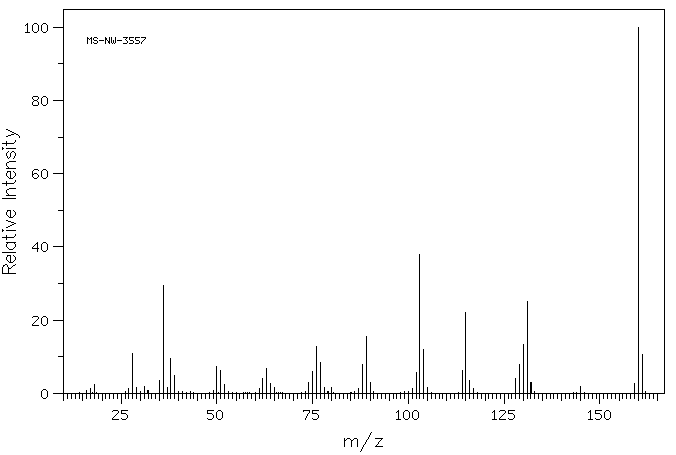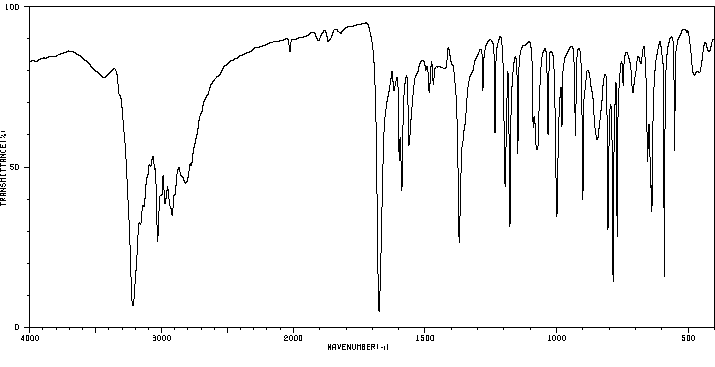盐酸肼屈嗪 | 304-20-1
-
物化性质
-
计算性质
-
ADMET
-
安全信息
-
SDS
-
制备方法与用途
-
上下游信息
-
文献信息
-
表征谱图
-
同类化合物
-
相关功能分类
-
相关结构分类
物化性质
-
熔点:273°C
-
沸点:322.13°C (rough estimate)
-
密度:1.2961 (rough estimate)
-
溶解度:易溶于水,微溶于乙醇(96%),极微溶于二氯甲烷
-
颜色/状态:Yellow crystals
-
气味:Odorless
-
稳定性/保质期:
稳定存放,避免与强氧化剂接触。
计算性质
-
辛醇/水分配系数(LogP):0.75
-
重原子数:13
-
可旋转键数:1
-
环数:2.0
-
sp3杂化的碳原子比例:0.0
-
拓扑面积:63.8
-
氢给体数:3
-
氢受体数:4
ADMET
安全信息
-
TSCA:Yes
-
危险等级:6.1
-
危险品标志:Xn
-
安全说明:S26,S36/37/39,S45
-
危险类别码:R22,R36/37/38
-
WGK Germany:3
-
海关编码:2942000000
-
危险品运输编号:UN 2811 6.1/PG 3
-
危险类别:6.1
-
RTECS号:TH9000000
-
包装等级:III
-
危险标志:GHS06
-
危险性描述:H301,H315,H319,H335
-
危险性防范说明:P261,P301 + P310,P305 + P351 + P338
-
储存条件:-20°C 冰箱
SDS
模块 1. 化学品
1.1 产品标识符
: Hydralazine hydrochloride
产品名称
1.2 鉴别的其他方法
1-Hydrazinophthalazinehydrochloride
1.3 有关的确定了的物质或混合物的用途和建议不适合的用途
仅用于研发。不作为药品、家庭或其它用途。
模块 2. 危险性概述
2.1 GHS-分类
急性毒性, 经口 (类别 3)
皮肤刺激 (类别 2)
眼睛刺激 (类别 2A)
特异性靶器官系统毒性(一次接触) (类别 3)
2.2 GHS 标记要素,包括预防性的陈述
象形图
警示词 危险
危险申明
H301 吞咽会中毒
H315 造成皮肤刺激。
H319 造成严重眼刺激。
H335 可能引起呼吸道刺激。
警告申明
预防措施
P261 避免吸入粉尘/烟/气体/烟雾/蒸气/喷雾.
P264 操作后彻底清洁皮肤。
P270 使用本产品时不要进食、饮水或吸烟。
P271 只能在室外或通风良好之处使用。
P280 穿戴防护手套/ 眼保护罩/ 面部保护罩。
事故响应
P301 + P310 如果吞下去了: 立即呼救解毒中心或医生。
P302 + P352 如果皮肤接触:用大量肥皂和水清洗。
P304 + P340 如吸入: 将患者移到新鲜空气处休息,并保持呼吸舒畅的姿势。
P305 + P351 + P338 如与眼睛接触,用水缓慢温和地冲洗几分钟。如戴隐形眼镜并可方便地取
出,取出隐形眼镜,然后继续冲洗.
P312 如感觉不适,呼救中毒控制中心或医生.
P321 具体处置(见本标签上提供的急救指导)。
P330 漱口。
P332 + P313 如觉皮肤刺激:求医/就诊。
P337 + P313 如仍觉眼睛刺激:求医/就诊。
P362 脱掉沾污的衣服,清洗后方可再用。
安全储存
P403 + P233 存放于通风良的地方。 保持容器密闭。
P405 存放处须加锁。
废弃处置
P501 将内容物/ 容器处理到得到批准的废物处理厂。
2.3 其它危害物 - 无
模块 3. 成分/组成信息
3.1 物 质
: 1-Hydrazinophthalazinehydrochloride
别名
: C8H8N4 · HCl
分子式
: 196.64 g/mol
分子量
组分 浓度或浓度范围
Hydralazine hydrochloride
<=100%
化学文摘登记号(CAS 304-20-1
No.) 206-151-0
EC-编号
模块 4. 急救措施
4.1 必要的急救措施描述
一般的建议
请教医生。 向到现场的医生出示此安全技术说明书。
吸入
如果吸入,请将患者移到新鲜空气处。 如呼吸停止,进行人工呼吸。 请教医生。
皮肤接触
用肥皂和大量的水冲洗。 立即将患者送往医院。 请教医生。
眼睛接触
用大量水彻底冲洗至少15分钟并请教医生。
食入
切勿给失去知觉者通过口喂任何东西。 用水漱口。 请教医生。
4.2 主要症状和影响,急性和迟发效应
皮疹, 发烧, 头痛, 心悸, 食欲不振
4.3 及时的医疗处理和所需的特殊处理的说明和指示
无数据资料
模块 5. 消防措施
5.1 灭火介质
灭火方法及灭火剂
用水雾,抗乙醇泡沫,干粉或二氧化碳灭火。
5.2 源于此物质或混合物的特别的危害
碳氧化物, 氮氧化物, 氯化氢气体
5.3 给消防员的建议
如必要的话,戴自给式呼吸器去救火。
5.4 进一步信息
无数据资料
模块 6. 泄露应急处理
6.1 作业人员防护措施、防护装备和应急处置程序
戴呼吸罩。 避免粉尘生成。 避免吸入蒸气、烟雾或气体。 保证充分的通风。 人员疏散到安全区域。
避免吸入粉尘。
6.2 环境保护措施
如能确保安全,可采取措施防止进一步的泄漏或溢出。 不要让产品进入下水道。
6.3 泄漏化学品的收容、清除方法及所使用的处置材料
收集和处置时不要产生粉尘。 扫掉和铲掉。 放入合适的封闭的容器中待处理。
6.4 参考其他部分
丢弃处理请参阅第13节。
模块 7. 操作处置与储存
7.1 安全操作的注意事项
避免接触皮肤和眼睛。 避免形成粉尘和气溶胶。
在有粉尘生成的地方,提供合适的排风设备。一般性的防火保护措施。
7.2 安全储存的条件,包括任何不兼容性
贮存在阴凉处。 使容器保持密闭,储存在干燥通风处。
7.3 特定用途
无数据资料
模块 8. 接触控制和个体防护
8.1 容许浓度
最高容许浓度
没有已知的国家规定的暴露极限。
8.2 暴露控制
适当的技术控制
避免与皮肤、眼睛和衣服接触。 休息前和操作本品后立即洗手。
个体防护设备
眼/面保护
面罩與安全眼鏡请使用经官方标准如NIOSH (美国) 或 EN 166(欧盟) 检测与批准的设备防护眼部。
皮肤保护
戴手套取 手套在使用前必须受检查。
请使用合适的方法脱除手套(不要接触手套外部表面),避免任何皮肤部位接触此产品.
使用后请将被污染过的手套根据相关法律法规和有效的实验室规章程序谨慎处理. 请清洗并吹干双手
所选择的保护手套必须符合EU的89/686/EEC规定和从它衍生出来的EN 376标准。
完全接触
物料: 丁腈橡胶
最小的层厚度 0.11 mm
溶剂渗透时间: 480 min
测试过的物质Dermatril® (KCL 740 / Z677272, 规格 M)
飞溅保护
物料: 丁腈橡胶
最小的层厚度 0.11 mm
溶剂渗透时间: 480 min
测试过的物质Dermatril® (KCL 740 / Z677272, 规格 M)
, 测试方法 EN374
如果以溶剂形式应用或与其它物质混合应用,或在不同于EN
374规定的条件下应用,请与EC批准的手套的供应商联系。
这个推荐只是建议性的,并且务必让熟悉我们客户计划使用的特定情况的工业卫生学专家评估确认才可.
这不应该解释为在提供对任何特定使用情况方法的批准.
身体保护
全套防化学试剂工作服, 防护设备的类型必须根据特定工作场所中的危险物的浓度和数量来选择。
呼吸系统防护
如危险性评测显示需要使用空气净化的防毒面具,请使用全面罩式多功能微粒防毒面具N99型(US)
或P2型(EN
143)防毒面具筒作为工程控制的候补。如果防毒面具是保护的唯一方式,则使用全面罩式送风防毒
面具。 呼吸器使用经过测试并通过政府标准如NIOSH(US)或CEN(EU)的呼吸器和零件。
模块 9. 理化特性
9.1 基本的理化特性的信息
a) 外观与性状
形状: 固体
b) 气味
无数据资料
c) 气味阈值
无数据资料
d) pH值
无数据资料
e) 熔点/凝固点
熔点/凝固点: 273 °C
f) 沸点、初沸点和沸程
无数据资料
g) 闪点
无数据资料
h) 蒸发速率
无数据资料
i) 易燃性(固体,气体)
无数据资料
j) 高的/低的燃烧性或爆炸性限度 无数据资料
k) 蒸气压
无数据资料
l) 蒸汽密度
无数据资料
m) 密度/相对密度
无数据资料
n) 水溶性
无数据资料
o) n-辛醇/水分配系数
无数据资料
p) 自燃温度
无数据资料
q) 分解温度
无数据资料
r) 粘度
无数据资料
模块 10. 稳定性和反应活性
10.1 反应性
无数据资料
10.2 稳定性
无数据资料
10.3 危险反应
无数据资料
10.4 应避免的条件
无数据资料
10.5 不相容的物质
强氧化剂
10.6 危险的分解产物
其它分解产物 - 无数据资料
模块 11. 毒理学资料
11.1 毒理学影响的信息
急性毒性
半数致死剂量 (LD50) 经口 - 大鼠 - 280 mg/kg
皮肤刺激或腐蚀
无数据资料
眼睛刺激或腐蚀
无数据资料
呼吸道或皮肤过敏
无数据资料
生殖细胞致突变性
无数据资料
致癌性
该产品是或包含被IARC, ACGIH, EPA, 和 NTP 列为可能不是致癌物的组分
IARC:
3 - Group 3: Not classifiable as to its carcinogenicity to humans (Hydralazine hydrochloride)
生殖毒性
实验室试验表明有畸胎生成效应
特异性靶器官系统毒性(一次接触)
吸入 - 可能引起呼吸道刺激。
特异性靶器官系统毒性(反复接触)
无数据资料
吸入危险
无数据资料
潜在的健康影响
吸入 吸入可能有害。 引起呼吸道刺激。
摄入 误吞会中毒。
皮肤 通过皮肤吸收可能有害。 造成皮肤刺激。
眼睛 造成严重眼刺激。
接触后的征兆和症状
皮疹, 发烧, 头痛, 心悸, 食欲不振
附加说明
化学物质毒性作用登记: TH9000000
模块 12. 生态学资料
12.1 生态毒性
无数据资料
12.2 持久性和降解性
无数据资料
12.3 潜在的生物累积性
无数据资料
12.4 土壤中的迁移性
无数据资料
12.5 PBT 和 vPvB的结果评价
无数据资料
12.6 其它不良影响
无数据资料
模块 13. 废弃处置
13.1 废物处理方法
产品
将剩余的和不可回收的溶液交给有许可证的公司处理。
联系专业的拥有废弃物处理执照的机构来处理此物质。
与易燃溶剂相溶或者相混合,在备有燃烧后处理和洗刷作用的化学焚化炉中燃烧
受污染的容器和包装
按未用产品处置。
模块 14. 运输信息
14.1 联合国危险货物编号
欧洲陆运危规: 2811 国际海运危规: 2811 国际空运危规: 2811
14.2 联合国运输名称
欧洲陆运危规: TOXIC SOLID, ORGANIC, N.O.S. (Hydralazine hydrochloride)
国际海运危规: TOXIC SOLID, ORGANIC, N.O.S. (Hydralazine hydrochloride)
国际空运危规: Toxic solid, organic, n.o.s. (Hydralazine hydrochloride)
14.3 运输危险类别
欧洲陆运危规: 6.1 国际海运危规: 6.1 国际空运危规: 6.1
14.4 包裹组
欧洲陆运危规: III 国际海运危规: III 国际空运危规: III
14.5 环境危险
欧洲陆运危规: 否 国际海运危规 国际空运危规: 否
海洋污染物(是/否): 否
14.6 对使用者的特别提醒
无数据资料
模块 15 - 法规信息
N/A
模块16 - 其他信息
N/A
制备方法与用途
盐酸肼屈嗪又称盐酸肼酞嗪,是已知的化合物。其化学名称为1(2H)-2、3-二氮杂萘酮腙(HydRAlazine),主要作用于松驰血管,常用于中度高血压的治疗,并通常与β-受体阻滞剂和利尿剂联合使用。
药理作用 降压盐酸肼屈嗪是一种直接作用于动脉和小动脉平滑肌的抗高血压药。通过舒张血管平滑肌降低外周阻力,从而达到降低血压的目的。它具有中等强度的降血压作用,显著降低舒张压,并能增加肾血流量。
心力衰竭盐酸肼屈嗪可增加心排出量,同时降低血管阻力和后负荷,有助于改善心脏功能。
药物相互作用 制备-
盐酸肼的生产:将50%水合肼与乙醇混合液滴加入氯化氢乙醇中,控制温度在-10°C至-15°C之间,生成盐酸肼乙醇溶液。最终pH值调节至2~4。
-
盐酸肼屈嗪的生产:在上述盐酸肼乙醇溶液中分批加入邻氰基苯甲醛,缓慢升温并将反应温度控制在45℃~50℃之间,持续24~48小时。反应结束后,用CP级盐酸调整pH值至1~2,降温后析晶、甩滤、洗涤干燥。
-
精制:将粗品按1∶1(M∶V)的比例投入乙醇溶液中升温溶解,加入适量活性炭脱色,压滤后降温析晶,甩滤并烘干。此过程的生产路线如下:
(此处插入图片)
HydRAlazine HCl 是HydRAlazine (Apresoline) 的盐酸盐形式,是直接有效的平滑肌松弛剂,IC50值为1.9 mM。
靶点- 钾通道
盐酸肼屈嗪对RAG-2基因的表达上调具有损害作用,并减少二次免疫球蛋白基因重排。它还能破坏B淋巴细胞自我容忍并通过受体编辑产生致病性自身反应性。
氧化应激- 盐酸肼屈嗪能直接清除acrolein,降低细胞内acrolein活性,从而抑制大分子内的收聚。
- 在处理30分钟后,盐酸肼屈嗪能够抑制交联,但在90分钟后作用无效。
- 通过ROS清除机制影响黄嘌呤氧化酶和烟酰胺腺嘌呤二核苷酸/烟酰胺腺嘌呤二核苷酸磷酸氧化酶的超氧自由基产生。
- 盐酸肼屈嗪能显著减少NO(*)生成,并且这种效应导致NOS-2基因表达和蛋白合成降低。同时,它也有效地阻止COX-2的基因表达以及PGE(2)的合成。
在豚鼠脊髓体外实验中,盐酸肼屈嗪不仅能保护acrolein介导的损伤,还能显著减轻acrolein诱导的超氧化物产生、谷胱甘肽耗尽及线粒体功能障碍,并降低复合动作电位传导。
体内研究在小鼠实验中,盐酸肼屈嗪剂量依赖性地保护血浆标记酶增加,但未完全阻止allyl醇引发的肝谷胱甘肽耗竭。
应用- 抗高血压药:主要用于治疗中度高血压。
反应信息
-
作为反应物:描述:盐酸肼屈嗪 在 palladium on activated charcoal sodium acetate 作用下, 以 甲醇 、 水 为溶剂, 反应 19.17h, 生成 3-(D-xylo-tetritol-1-yl)-1,2,4-triazolo<3,4-a>phthalazine参考文献:名称:3-(醛糖醇-1-基)-1,2,4-三唑并[3,4-a]酞嗪的合成摘要:摘要1-肼基酞嗪(肼苯并肼)与d-糖,d-核糖,d-木糖,d-甘露糖和l-鼠李糖的缩合得到相应的醛糖-邻苯二甲酸酞嗪-1-基hydr唑酮。另一方面,d-阿拉伯糖和d-半乳糖通过hydr的自脱氢环化反应得到了相应的3-(醛醇-1-基)-1,2,4-三唑并[3,4-a]酞嗪。讨论了这种差异的基本原理。后者的乙酰化得到聚-O-乙酰基衍生物。木炭上的钯催化或脱氢环化或乙酰化,可将nes转化为三唑并萘二甲酸酯或它们的乙酸酯。讨论了合成化合物的质谱。DOI:10.1016/s0008-6215(00)85294-5
-
作为产物:描述:2-formylphenyl tosylate 在 palladium(II) trifluoroacetate 、 肼基甲酸叔丁酯 、 1,3-双(二苯基膦)丙烷 、 magnesium sulfate 、 potassium carbonate 、 三氯氧磷 作用下, 以 乙腈 为溶剂, 60.0~140.0 ℃ 、1.0 MPa 条件下, 反应 23.5h, 生成 盐酸肼屈嗪参考文献:名称:通过钯催化的2-甲酰基芳基甲苯磺酸盐,肼和CO的三组分环氨基羰基化反应获得邻苯二氮酮摘要:已经建立了用肼和一氧化碳进行钯催化的2-甲酰基芳基甲苯磺酸酯的三组分环氨基羰基化反应,这为合成取代的邻苯二氮酮提供了一种有效的方法。此外,通过将该方案用作关键步骤,可以轻松以65%的产率合成肼屈嗪。DOI:10.1016/j.tet.2016.10.065
-
作为试剂:描述:参考文献:名称:A Convenient Synthesis of 4-Acetyl-5-hydroxy-3-methyl-1-substituted Pyrazoles摘要:Reaction of 1-(5-hydroxy-3-methyl-1-substituted-4-pyrazolyl)-1, 3-butanediones (1a-d) with 1-hydrazinophthalazine hydrochloride leads to the formation of 4-acetyl-5-hydroxy-3-ethyl-1-substitutedpyrazoles (3a-d) along with 3-methyl-s-triazolo[3,4-a] phthalazine (4) in good yields.DOI:10.1080/00397919408010577
文献信息
-
Pharmaceutical preparation containing copolyvidone申请人:Takeda Pharmaceutical Company Limited公开号:US10098866B2公开(公告)日:2018-10-16A stabilized preparation which comprises: a unstable drug in a polyethylene glycol-containing preparation; and a coating agent comprising a copolyvidone instead of polyethylene glycol with which the drug is coated.
-
Sulfonyl-containing 2,3-diarylindole compounds, methods for making same, and methods of use thereof申请人:——公开号:US20040058977A1公开(公告)日:2004-03-25The present invention relates to sulfonyl-containing 2,3-diarylindole, especially to new compounds of general Formula, to a preparation method for their preparation, to pharmaceutical compositions containing said compound, and to the medical use thereof in the treatment of diseases relating to the inhibition of cyclooxygenase-2 (COX-2).本发明涉及含砜基的2,3-二芳基吲哚,特别涉及一般式的新化合物,其制备方法,含有该化合物的药物组合物,以及在治疗与环氧合酶-2(COX-2)抑制有关的疾病中的医疗用途。
-
BICYCLIC COMPOUNDS AND USE AS ANTIDIABETICS申请人:Fang Jing公开号:US20100029650A1公开(公告)日:2010-02-04The present invention relates to novel compounds that are useful in the treatment of metabolic disorders, particularly type II diabetes mellitus and related disorders, and also to the methods for the making and use of such compounds.本发明涉及一种新型化合物,该化合物在治疗代谢性疾病,特别是Ⅱ型糖尿病及相关疾病方面具有用途,并且还涉及制备和使用这种化合物的方法。
-
[EN] FUMAGILLOL COMPOUNDS AND METHODS OF MAKING AND USING SAME<br/>[FR] COMPOSÉS DE FUMAGILLOL, ET LEURS PROCÉDÉS DE FABRICATION ET D'UTILISATION申请人:ZAFGEN INC公开号:WO2018031877A1公开(公告)日:2018-02-15Disclosed herein, in part, are fumagillol compounds and methods of use in treating medical disorders, such as obesity. Pharmaceutical compositions and methods of making fumagillol compounds are provided. The compounds are contemplated to have activity against methionyl aminopeptidase 2.
-
HETEROCYCLIC COMPOUND申请人:Takeda Pharmaceutical Company Limited公开号:US20170015655A1公开(公告)日:2017-01-19The present invention provide a heterocyclic compound having a HDAC inhibitory action, and useful for the treatment of autoimmune diseases and/or inflammatory diseases, graft versus host disease, cancers, central nervous diseases including neurodegenerative diseases, Charcot-Marie-Tooth disease and the like, and a pharmaceutical composition comprising the compound. The present invention relates to a compound represented by the formula (I): wherein each symbol is as defined in the specification, or a salt thereof.
表征谱图
-
氢谱1HNMR
-
质谱MS
-
碳谱13CNMR
-
红外IR
-
拉曼Raman
-
峰位数据
-
峰位匹配
-
表征信息










